This time I would like to talk about my obsession with the two games designed by The Logic Factory. I was always quite fond of the more popular Acendancy. Recently, I have discovered the less popular The Tone Rebellion (aka “Leviathan” in Germany). Although I try to be cautious with superlatives I must admit that it turned out to be one of the best games I have every played.
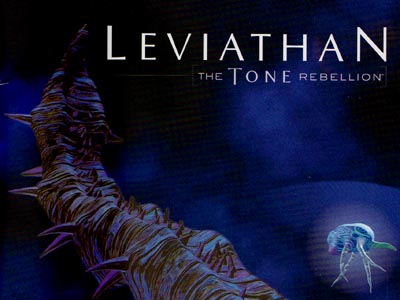
There should be a law which forced every game developer in the world to hang a printout of the cover of The Tone Rebellion on a wall in his office just so he remembers what is possible.
The Tone Rebellion is revolutinary in many ways. Possibly I will get into some of the gameplay aspects in future articles. However, the thing that I found most intriguing and fascinating is its incredibly bold and unusual theme. It makes you realize how limited and poor modern games are in that sense. I think every game designer should at least briefly take a look at it, so without further ado…
The Tone Rebellion is like nothing you have seen before. It is about strange octopus-like creatues that live on bizzare islands that hover in something that looks like space. The creatures are able to move by simply floating through the air – hence, they are called “Floaters”. There are 4 different tribes of Floaters, some look more like insects, some look like frogs. Your goal is to take control of one tribes, collect some mysterious enenergy called “Tone” to build buldings so you can defend yourself against the even more grotesque Enemies. You collect strange artefacts, use the artefacts to obtain ancient wisdom and use that wisdom to break the magical seals that have captured your ancestors and thus, you save the world.
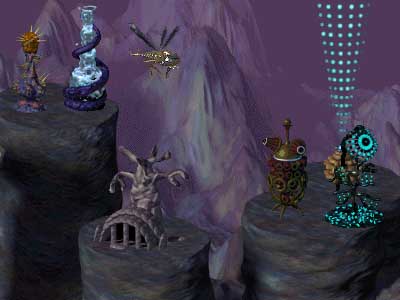
In The Tone Rebellion, you fight against weird bottles, trees, dragonflys, pulsating plants and spores… of evil!
Logic Factory already drew some attention to them by using some unique visual style on their first game, Ascendancy. Instead going for photorealism, as everybody does, they used convetional 3D rendering techniques to create unfamiliar and truly alien assets. Although Ascendancy was a fairly traditional space 4X game, some interesting UI choices and the unique visual stlye made the game stand out from the crowd. The same visual style is even more prominent in The Tone Rebellion and contributes to the insane theme.
Interestingy, the development can be seen in the music as well. Ascendancy had a very orchestral and bold soundtrack. It had a lot of unique qualities and successfully captured the feeling of witnessing a civilization develop over centuries. It was the kind of soundtrack you sometimes hear in scientific documentaries. The soundtrack in The Tone Rebellion is simmilar but more mystical and religious. When was the last time you were listening to Gregorian chants while playing a strategy game?
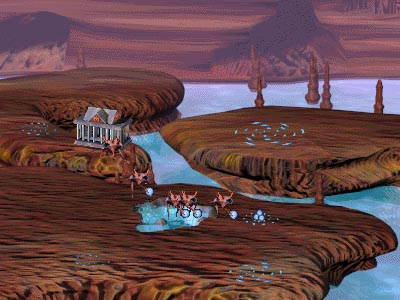
The pink tenacles-and-blue-lips-floating-guys are stacking up the blue, glowing cotton balls on one of the particle-whirlpools to build the first building. I could swear I had a dream like that once.
The effects of these choices are extraordinary. The game doesn’t recreate a special fantasy. By failing to adress any familiar theme so consequently, it triggers an even more universal instinct: curiousity. It may sound a bit pompous but curiosity lies at the heart of human motivation. Without curiosity, we would be either stil living on trees or we would be extinct. The fascination of exploring something new is a desire perfectly matched by The Tone Rebellion. In every way, the game a new world for you to explore and interact with.
On a sidenote, it is a bit sad that game designers couldn’t part with concepts like enemies and fighting. But I guess changing even that would push the game beyond all comprehension. The game provides short, nice texts about philosophy of conflict in general, which at least sheads some mystical twilight on all the fighting and might be even something the players might want to remember and use outside the game.
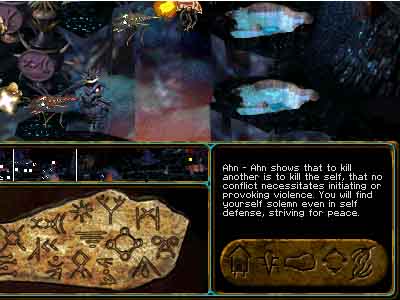
“To kill another is to kill the self”. Although it is a nice advice, the game does not give me much choices other then to blast my way trough the hordes of pulsating flowers and burning honeycombs.
Some time ago, we already mentioned that a non-standart interface is something worth to look into. A new, unique theme has also a lot of advantages, which are apparent in The Tone Rebellion.
1. You are able to work with the medium, not against the medium. Everybody, who worked with computers realizes, that some things, which seem easy and straight-forward in real life, are insanely difficult to recreate with a computer. For instance, making a character walk properly on a flat surface requires a lot of work because it is a complex movement and his feet need to interact correctly with the ground underneath. It is much easier to let somebody fly or even instantly teleport from place to place, which on the other hand is very difficult in real-life. By using a unique theme, the Logic Factory was able to save a lot of work. In The Tone Rebellion, the units all just float without really moving their limbs. There is even almost no such thing as collision detection at all, hence no need for complex route finding. Yet, the players don’t miss them, everything appears naturally. This wouldn’t be possible of the units were human or in any way familiar.
2. You have more freedom designing the game mechanics. So for instance, if you realize that the battle system of you game works better if there are no close-combat units, there is nothing that stops you from doing so. On the other hand, try explaining why there are no swordfights in you medial-themend game. The Tone Rebellion features a lot of unusual and great game mechanics, which would be hard to pull of in a traditional theme. For instance, you can simply teleport whole buildings from place to place.
3. You avoid competiton. In “Der Hai im Management” (”The Shark in Management”) Hans Haas describes how because our primal instincts companies tend to try to repeat the success of other companies and thus create unnecessary competition. A smarter approach would be to seek a fundamentally different strategy. This creates an environment where your sucess doesn’t necessarly require the failure of you competition. Just observe how cleverly Nintendo places the Wii on the market.
So, when Diodor Bitan chose a traditional space theme for Pax Galaxia, we started comparing it to other space 4X games like Master of Orion. By chosing a unique theme, a game won’t compete with games it shouldn’t be compared to in the first place.
4. You avoid prejudices and adress new target groups. Familiar themes have been around for some time and are associated with certain values and target groups. This fact is of course the reason to choose a familiar theme but it can also work strongly against you. My girlfriend will discard everything Sci-Fi outright as childish and stupid. I cannot blame her, Sci-Fi has seen a lot of bullshit. If game designers keep on using the same themes, our audience will always stay the same. By experimenting with new and unique themes, we might be able to reach new audiences.
However, there is a flipside to it. I do not think The Tone Rebellion was successful among new target groups. In fact, it was generally unsuccessful. The Logic Factory have failed realize that a unique theme is a COMMITMENT to new target groups. They would have been more successful if they tried selling the game to different people. Instead, it was sold as every other game to the same audience again.
5. This brings us to the most important part. The success of familiar themes is based of repetition. So, a theme has become popular because of some other work (”Lord of the Rings” for example) and now you repeat it over and over again. The more exactly you repeat the theme, the better you adress people, who are already fond of the theme. Deviation from the theme is often punished by disregard by that people – it is a cybernetically stable System.
This repetition might be ok for some designers because it is easy and it certainly does pay off. However, only the initial work will always be the one that is praised and remembered in history books because it was unique and new at the time it was released(”Lord of the Rings”). The repetitions are soon forgotten because they are exchangeable.
This is going to be cheesy now. The fundamental question is: “Why do you make games anyway?”. This is yet another eternal question and every artist, writer, fimmaker has to find his own answer. Although my answer is complicated and difficult to put into words, I try to explain what kind of games I DO NOT want to make. I do not want to make redundant and exchangeable games. I don’t want to waste my time on yet another GTA, another World of Warcraft or another Halo. I see no point in that endeavour and I honestly don’t see how any smart person would want to do that.
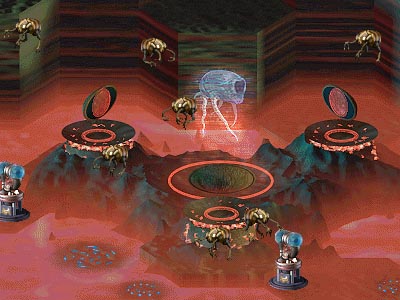
As you can imagine, this is the game with the highest StC known to man! Not even the concept of such thing as a crate exists in this world.
So a unique theme has a lot to do with my motivation as a game designer. But just a theme is not enough. A FPS with a unique theme is still yet another FPS. Note how Logic Factory exploits the advantages of their theme to get the most out of their medium. Note how they use a different visual style and different music to enhance that theme. Note how the uniqueness of the theme is reflected in the gameplay. Note how in concert with Ascendancy, it creates a consistent The Logic Factory Stlye. It is bold and well executed and a fine example of smart and innovative game design.






Insightful! I hadn’t thought about your points 1 & 2 in the context of weird themes before. As usual, though, I’m going to devote more words to the bits I disagree with.
3 & 4 are true as far as they go, but I think they don’t actually award a marketing advantage, because completey new, strange material alienates pretty much everybody. People that hate SF & Fantasy are likely to reject anything that doesn’t resemble our real world, and many SF & Fantasy fans reject anything that violates genre conventions, so what you end up with is a niche that has, as you say, no competition, but also very limited appeal. Even if your theme has the potential to start a new cult, you have to make first contact somehow; most potential customers just skim the names & pictures of games they’re considering playing, looking for something attractive, which means familiar. Of course, there are a few freaks out there (like you and me, apparently) whose eye is caught by the bizarre, so it isn’t completely hopeless.
Point 5 also resonates with me, although I think it important that art is practically never really revolutionary. Tolkien may have invented Fantasy, but he did it by riffing on established mythology — and I think that was essential to his success, although that’s hard to prove. Impressionism and abstract art developed in small steps. Dali is a lot like Renaissance art, and even his off-the-wall bits turn into recurring themes (forked sticks, burning giraffes), which is like making a sequel to a successful innovative game.
What I’m getting at is that, while copying existing games sucks for all the reasons you mention, trying to be an unique as possible may also not be the right goal, artistically or commercially.
Thank you for your comments, I find them always very intriguing. I agree almost with everythig you said, so everyhing I can do is just to add something to your thoughts.
I think mechanics of target groups and “familiar” themes are incredibly complex. It may be true that people, who hate Sci-Fi may be attracted to rather “realisitic” themes. But a bizzare and unique theme can be “realistic” as well, think of something like Franz Kafka, for example.
I think concerning target groups, it gets more and more difficult to use “The Tone Rebellion” as the only example because, although its theme is quite strange, it has generally some paralells to traditional Sci-Fi Themes. You have space, aliens etc.
What about games like “Myst”, which were quite surreal and were quite popular with older players.
Also, as you have mentioned, you need to establish some “first contact” to new target groups. I completly agree! That didn’t happen in “The Tone Rebellion”. I don’t know so well about “Myst” but I remember that it was being sold and used as a demo in rather serious PC (and Apple!)Stores.
If you want to adress new customers, don’t even think about such things as them going in a store and skimming through names and pictures. People, who don’t play games simply don’t cosider playing a game, they will never set foot in a games store. Even if they did, they would be instantly driven away by the intimidating atmosphere. Imagine your parents in a local EB Games, they would be lost and confused. You have think about how to meet such customers somewhere else. At a theatre, in a books store, in a museum, while waiting for a train, etc.. What you want to archieve is a stituation where they wouldn’t realize that they are about to play a computer game. You have to challenge their views and prejudices of what a computer game is. I think a unusual theme might be quite helpful at doing so.
As for what is “really revolutionary”: Communication in general is based on recombination and transformation of already known elements. On the other hand, everything we percieve is always judged and evaluated by comparing it to previous works. I think the term “true innovation” is overused, overhyped and simply misunderstood. It fits well to what you said at the end. I agree that just being “unique” for the sake of it is quite short-sighted. But then again, so is blind immitation.
Innovation shouldn’t be a goal to work towards. It should be rather part of what you do. You can see in “The Tone Rebellion” that the unique theme isn’t just something that has been tacked-on. It is an integral part of the game and I believe that the game would have been more successfull if Logic Factory had been consequent enough include even marketing in their strategy.
Avant-garde vs. Mainstream, has been discussed for years and I doubt we will come to a conculsion here. I would like to add some last thoughts:
So far, games have been quite market-oriented. I think this is what keeps them from gaining much attention as part of our culture. We have to change that. I believe that goverment funding for games might face game designers with the question of what they want to archieve with their games. Just because some stuff sells well doesn’t mean that it is a good and valuable idea.
sascha just now mentioned that he likes my setting-idea of “solsys” because it reminds him of the strangeness of “captain blood”.
well – do you know captain blood? i didn’t and reading the wikipedia article, it sounds like it could be very close to what you like about tone rebellion.
check it out: http://en.wikipedia.org/wiki/Captain_Blood_%28video_game%29
(its the old atari/amig game, not the newer xbox game that is near the original novell of a totally different content
I would like to say that I simply adore The Tone Rebellion, as it is the game of my childhood. I just love the lush music and graphics, and how it fills me with insatiable curiosity to discover the history and story, and, since I no longer have the CD, this is, sadly, and impossibility. From the mists of memory I have managed to remember that there was some sort of great diety whom the floaters worshipped, and you needed to find all his pieces. Also, thanks to this excellent website, I have remembered the little teachings, like the one you posted about Ahn. I simply cannot stop thinking about them.
I absolutely adored this game. I was just listening to some meditation music that was strikingly close to the soundtrack of the game (at least one of the pieces) and was suddenly torn back to the memory of little octopi-like fellows piling tone-spheres into a building. I had completely forgotten about the game. I played it SO many times, I can’t even recall. Adored it. Maybe I’ll go buy a used copy somewhere.